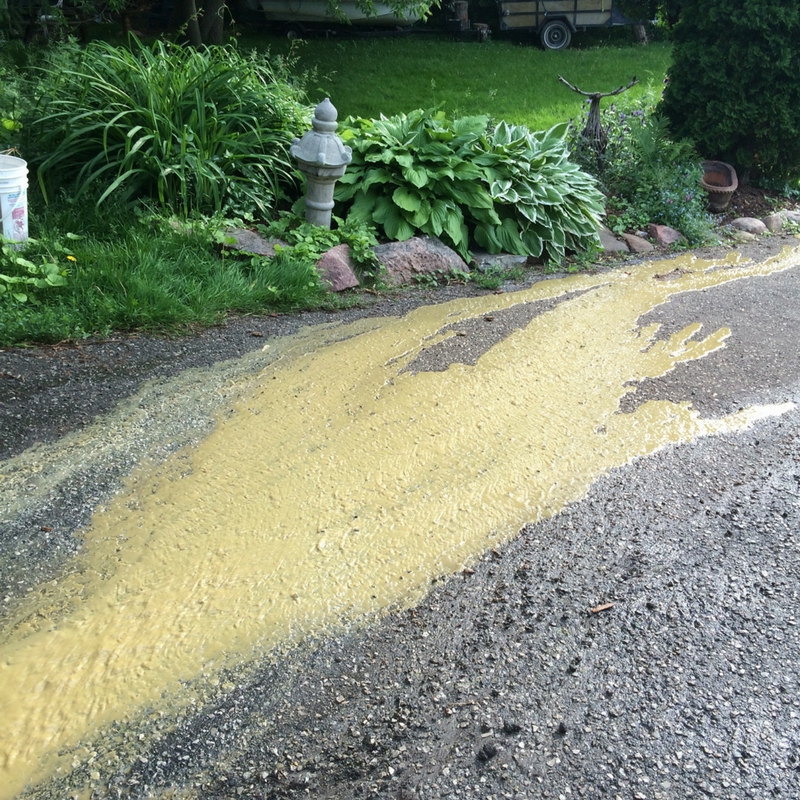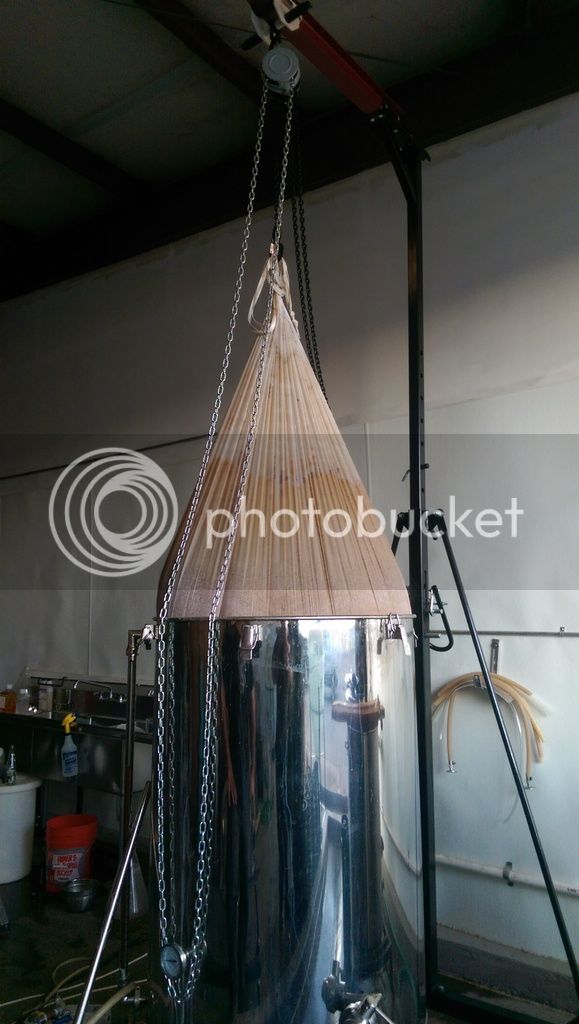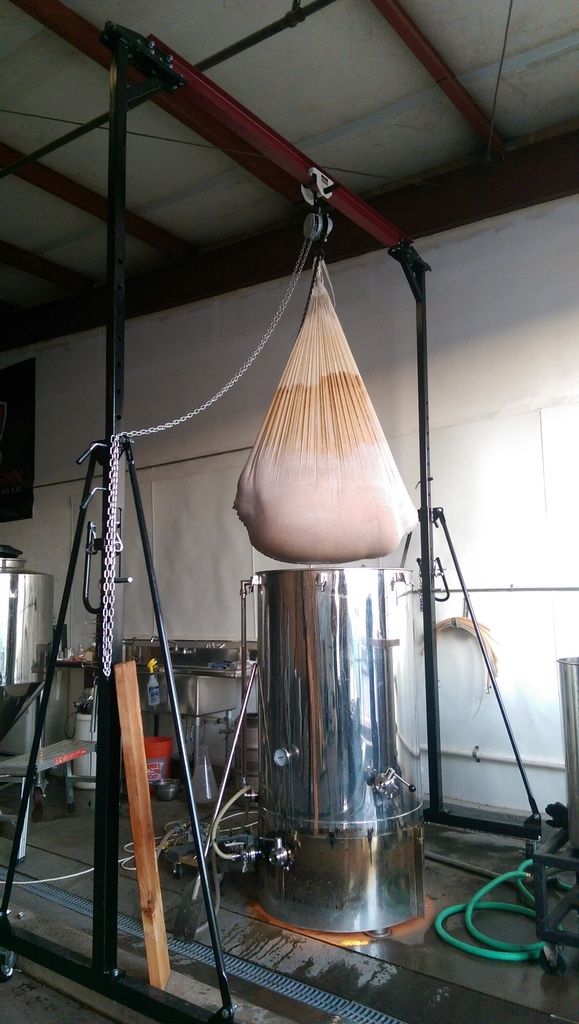ThrappersAle
Member
- Joined
- Sep 22, 2016
- Messages
- 21
- Reaction score
- 14
Hi Fellow brewers
I thought I’d chime in for once after absorbing everyone else’s information and keeping it as my own. We do 2 x 65 gallon brews in a day, BIAB style. I thought I’d share our process and hopefully someone out there will get some ideas, learn something, or at least be entertained. Also feel free to ask questions. Comments and suggestion encouraged.
Our brew day starts around 8 am, after we’ve pre milled our grain and measured out the hops the night before. We set the kettles up, level them and completely drain my hot water tank into the first kettle and then the next kettle ends up with cold water.
We heat the kettles with 210k btu banjos, this brings the first one up to mash temp in about 45 minutes, then next one takes about an hour 20.
We have a big bag that fits over our 75 gallon pots, and some backup smaller bags in case one the other kettle is up to temp before the first one finishes the mash.
We used to recirculate the mash and fire the kettle to keep temps during the mash but this proved to be troublesome. Be burned our bag (more than once) and if it does work it gets sucked into the kettle spout and the bottom and stalls our chugger pump. Pain in the butt. Now we use reflectix around the kettle to insulate and keep temps. Way easier.
It takes 2-3 guys and the help of a winch to get our 140 lbs of grain ( that is now wet and probably weighs 250lbs or more) out of the kettle. Once that’s done we squeeze, wash, and let it hang over the kettle to drain until it reaches a boil, or until the other kettle needs the winch.
We dump the grains via wheel barrow in the forest beside my house. We have to cover it with dirt and brush, because wow does it stink in a couple days. I would like to do something better than dump over 300 lbs of spent grain in a forest every few months but my dog can only eat so many grain cookies.
We have started keeping a third pot with about 30 gallons in it over our old turkey fryer burner to bring the water up to temp to wash the hanging grain bag and top up the boil kettle after grain absorption. This saves us about 45 minutes at the end of the day because we used to top up with coldish water from the hose bringing our wort down to about 100 degress, and let me tell you, watching 70 gallons of water boil is painful.
Once were up to boil we pitch our hops (about 130 ounces per kettle including dry hop), and then chill with 3 chillers. One is a half inch 50 ft copper immersion, another is a ¾ inch 50 ft copper immersion and the other is a 25 ft ½ inch counterflow (used to be 50 ft, don’t ask, haha), This still takes us about an hour 15 (during the summer) to get down to pitching temps.
Then we pitch our yeast, sanitize our homemade stainless lids, and shrink wrap them to the kettle. We used to use carboys but that was getting pretty tedious so we decided to ferment in the boil kettle. And it has worked out great, no off flavors, ferments great, and super easy, almost feels like we’re cheating.
Kegging day is like a production line. We rinse, oxyclean, rinse, sanitize. Then we use our ½ autosiphon attached to our chugger pump and fill the kegs through our keg strainer bag (same material as the BIA bag, swiss voile) So many hops (50-60 ounce dry hop) we have to use a bag.
Brew day is about 10-12 hours and keg day about 4-5. Long, but worth it. We're making some seriously good brew. Strictly IPA's and better than 80% of the commercial stuff we have near us.
Anyway, thanks for reading, and thanks to everyone on the forum for the insane amount of knowledge and helpfulness.
Heres a few pics, i realize I don’t have many, and these ones are outdated as our setup is a little different now, but brew days are really busy, I’ll take some more next time and add them in.






I thought I’d chime in for once after absorbing everyone else’s information and keeping it as my own. We do 2 x 65 gallon brews in a day, BIAB style. I thought I’d share our process and hopefully someone out there will get some ideas, learn something, or at least be entertained. Also feel free to ask questions. Comments and suggestion encouraged.
Our brew day starts around 8 am, after we’ve pre milled our grain and measured out the hops the night before. We set the kettles up, level them and completely drain my hot water tank into the first kettle and then the next kettle ends up with cold water.
We heat the kettles with 210k btu banjos, this brings the first one up to mash temp in about 45 minutes, then next one takes about an hour 20.
We have a big bag that fits over our 75 gallon pots, and some backup smaller bags in case one the other kettle is up to temp before the first one finishes the mash.
We used to recirculate the mash and fire the kettle to keep temps during the mash but this proved to be troublesome. Be burned our bag (more than once) and if it does work it gets sucked into the kettle spout and the bottom and stalls our chugger pump. Pain in the butt. Now we use reflectix around the kettle to insulate and keep temps. Way easier.
It takes 2-3 guys and the help of a winch to get our 140 lbs of grain ( that is now wet and probably weighs 250lbs or more) out of the kettle. Once that’s done we squeeze, wash, and let it hang over the kettle to drain until it reaches a boil, or until the other kettle needs the winch.
We dump the grains via wheel barrow in the forest beside my house. We have to cover it with dirt and brush, because wow does it stink in a couple days. I would like to do something better than dump over 300 lbs of spent grain in a forest every few months but my dog can only eat so many grain cookies.
We have started keeping a third pot with about 30 gallons in it over our old turkey fryer burner to bring the water up to temp to wash the hanging grain bag and top up the boil kettle after grain absorption. This saves us about 45 minutes at the end of the day because we used to top up with coldish water from the hose bringing our wort down to about 100 degress, and let me tell you, watching 70 gallons of water boil is painful.
Once were up to boil we pitch our hops (about 130 ounces per kettle including dry hop), and then chill with 3 chillers. One is a half inch 50 ft copper immersion, another is a ¾ inch 50 ft copper immersion and the other is a 25 ft ½ inch counterflow (used to be 50 ft, don’t ask, haha), This still takes us about an hour 15 (during the summer) to get down to pitching temps.
Then we pitch our yeast, sanitize our homemade stainless lids, and shrink wrap them to the kettle. We used to use carboys but that was getting pretty tedious so we decided to ferment in the boil kettle. And it has worked out great, no off flavors, ferments great, and super easy, almost feels like we’re cheating.
Kegging day is like a production line. We rinse, oxyclean, rinse, sanitize. Then we use our ½ autosiphon attached to our chugger pump and fill the kegs through our keg strainer bag (same material as the BIA bag, swiss voile) So many hops (50-60 ounce dry hop) we have to use a bag.
Brew day is about 10-12 hours and keg day about 4-5. Long, but worth it. We're making some seriously good brew. Strictly IPA's and better than 80% of the commercial stuff we have near us.
Anyway, thanks for reading, and thanks to everyone on the forum for the insane amount of knowledge and helpfulness.
Heres a few pics, i realize I don’t have many, and these ones are outdated as our setup is a little different now, but brew days are really busy, I’ll take some more next time and add them in.









